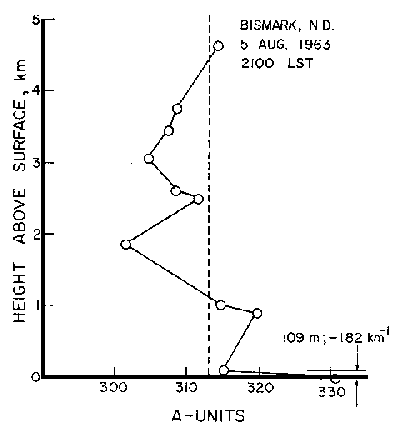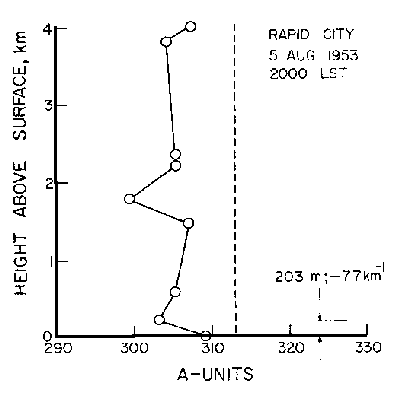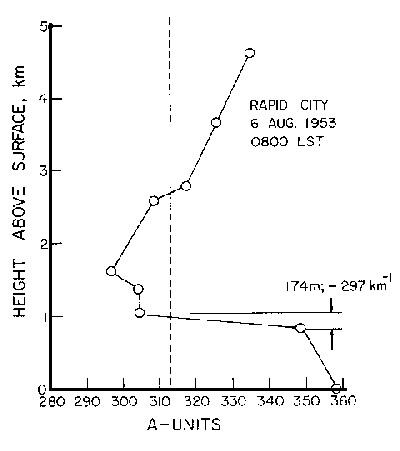15-B. Blackhawk and Rapid City, S. Dak., and Bismarck, N. Dak., 5-6 August 1953, 2005-0250 LST. Weather: clear, excellent visibility, stable conditions, temperature inversions and radio surface ducts prevalent. See Fig. 4. The night was dark and moonless.
The initial incident in this chain of UFO sightings was the sighting by a GOC (Ground Observers Corps) observer of a stationary "red glowing light" at 2005 LST near Blackhawk, S. Dak. This light soon began to move some 30° to the right, "shot straight up," and moved to the left, returning to its original position. A companion thought it was "just the red tower light" (a warning light on an FM
- 196 -

Figure 4
Radio Refractivity Profile
Bismark, 5 Aug 63
- 197 -
transmitter tower normally just visible from their location). The report was relayed to the Rapid City Filter Center, and three airmen from the radar site were sent outside to look for the UFO. They saw what was undoubtedly a meteor, judging from their description. The radar operator when informed of the new sighting began to search for unidentified targets. He found many.
Over the course of the next four hours a large number of unidentified blips appeared on the Rapid City radar. Many of those were transitory, moving blips with a fairly short lifetime, usually being "lost in the ground clutter." An F-84 fighter was vectored in to a stationary blip near Blackhawk, and the pilot "chased" a UFO which he found at the location on a heading of 320 ° M. without gaining on it. The F-84 was probably chasing a star, in this case Pollux (mag. 1.2) which was in the correct location (335° true azimuth, near the horizon).
When the Blackhawk GOC post called in that the original object had returned for a third time, another F-84 was vectored in on the visual report, as no radar contact could be made. The pilot made a visual contact and headed out on a 360 ° magnetic (~15° true) vector. At this point the radar picked up what apparently was ghost echo, that is, one that "paced" the aircraft, always on the far side from the radar. The fighter in this instance was probably chasing another star, the image of which may have been somewhat distorted. The pilot's report that the visual UFO was "pacing" him appears to have strengthened the radar operator's belief that he was actually tracking the UFO, and not a ghost echo. The star in this instance may well have been Mirfak (mag. 1.9), which, at 2040 LST, was at azimuth 15 ° and about 5 ° to 7 ° elevation angle. The second pilot, upon being interviewed by Dr. Hynek, stated that he felt he had been chasing a star, although there were some aspects of the
- 198 -
appearance of the object that disturbed him. He also stated that the radar gunlock. which he had reported by radio during the chase, was due to equipment malfunction, and that the radar gunsight continued to malfunction on his way back to the base. This equipment was never subsequently checked for malfunctioning (i.e., not before or during the official AF investigation of the incident).
The Bismarck, N. Dak. sightings began when the Bismarck Filter Center was alerted to the "presence of UFO's" by Rapid City. At 2342 LST the sergeant on duty there and several volunteer observers went out on the roof and shortly spotted four objects. The descriptions of these objects by the various observers were consistent with the hypothesis that they were stars, although some apparent discrepancies caused early AF investigators to deduce by crude triangulations that the sighted objects must have been nearby. It now appears that all four objects were stars viewed through a temperature inversion layer. The observers stated that the objects resembled stars, but that their apparent motion and color changes seemed to rule out this possibility.
Dr. Hynek's summary of the probable nature of the four Bismarck objects is enlightening:
Object #1, which was low on the horizon in the west and disappeared between midnight and 0100 hr. was the star Arcturus observed through a surface inversion. Arcturus was low on the horizon in the west and set at approximately 1220 (LST) at 289 ° azimuth.
Object #2 -- was the star Capella observed through a surface inversion. At 0011 CST Capella was at 40° azimuth and 15 ° elevation ... [and] at 0200 CST [it] was at 53° azimuth and 30 ° elevation, which agrees with the positions given by [the two witnesses].
Objects #3 and #4 were, with a high degree of probability, the planet Jupiter and the star Betelgeuse, observed through
- 199 -
a surface inversion. Jupiter's ... stellar magnitude was -1.7 [and it] was low on the eastern horizon at approximately 92° azimuth. Betelgeuse ... was also low on the eastern horizon at approximately 81° azimuth.
The statement of one of the witnesses at Bismark includes the following comments:
... they appeared much brighter than most of the stars and at times appeared to take on a rather dull bluish tint.
They appeared to move in the heavens, but at a rather slow rate and unless a person braced his head against some stationary object to eliminate head movement it would be hard to tell that they were moving.
The one in the west eventually disappeared below the horizon and the one in the northeast gradually seemed to blend in with the rest of the stars until it was no longer visible.
The last statement is typical of the description given by witnesses who have apparently observed a bright star rising through an inversion layer. It would seem to be circumstantial evidence of the diffraction-brightening predicted by Raman for propagation along an inversion layer (see Section VI Chapter 4). However, there is an alternative explanation that simple diffractive blurring or smearing of a star's image, by spreading the available light over a larger area of the eye's retina, may cause a psychological illusion of brightening of the object.
The meteorological conditions were generally favorable for anomalous propagation at both locations. The refractivity profile for Rapid City 2000 LST 5 August shows a 0.5 ° C temperature inversion over a layer 109 m. thick, although the resulting refractivity gradient is only -77 km-1 (Fig. 5). The 0800 LST profile (Fig. 6) shows a pronounced elevated
- 200 -

Figure 5
Radio Refractivity Profile
Rapid City, 5 Aug 53
- 201 -

Figure 6
Radio Refractivity Profile
Rapid City, 6 Aug 53
- 202 -
duct between 833 and 1,007 m. with a gradient of -297 km-1; a 3.2 ° elevated inversion is reported through this layer. A strong inversion layer evidently formed during the night and was "lifted" to the 833 m. level by solar heating after sunrise at about 0500 LST.
The Bismarck profile for 2100 LST 5 August (Fig. 4) shows a 1.2°C temperature inversion between the surface and the 109 m. level, the resulting layer forming a radio duct with a refractivity gradient -182 km-1. It is noteworthy that the Bismarck sightings show more evidence of optical inversion-layer effects than the Rapid City sightings.
In summary, the Rapid City-Bismarck sightings appear to have been caused by a combination of: